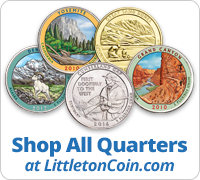
Everglades National Park quarter design
In November of 2013, the U.S. Mint revealed the final design for Florida’s Everglades National Park quarter. As the fifth release for 2014, this beautiful quarter will feature the Anhinga bird with outstretched wings and a Roseate Spoonbill in the background.
Both of these unusual birds call the Everglades home. The dark-colored Anhinga lives in fresh water marshes where it can be seen diving and swimming after fish. It is also known as the Snakebird because its long neck and head are the only things you see sticking out of the water as it swims.
The pink-colored Roseate Spoonbill is often confused with the Flamingo. Using its odd-shaped bill like a spoon, this distinctive wading bird moves its head from side to side in shallow water catching small fish, insects and crustaceans, and swallowing them.
Joel Iskowitz created the quarter’s reverse design and Joseph Menna engraved it. The inscriptions read, name of the site: everglades, florida, year of issue: 2014 and the motto: e pluribus unum.
This handsome quarter is a perfect match for the 2004 Statehood Quarter which also featured Florida, the park’s home state. As 25th in the series overall, the Everglades quarter will be the fifth coin for 2014.
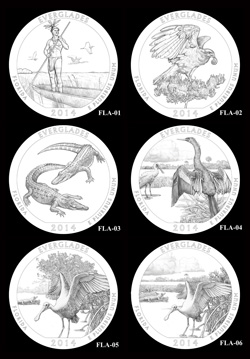
Everglades National Park quarter candidate designs
In November 2012, the Citizen’s Coinage Advisory Committee and the Commission of Fine Arts reviewed designs for the reverse of the 2014 Everglades National Park quarter. A total of 6 designs were submitted, and five of them featured wildlife found within the park. Four showed birds and the fifth featured the alligator/crocodile. The sixth coin depicted a Native American standing in a dugout recalling the park’s importance to the indigenous people.
The Everglade’s distinct landscape and waterways support a diverse group of plants, animals, birds, and reptiles. There are over 40 different mammals ranging from raccoons, opossums and white tailed deer to Florida panthers, bats and armadillos. Also, more than 50 reptiles can be found: snakes, alligators and crocodiles, lizards, geckos and turtles. It’s no wonder the candidate designs for the 5th National Park quarter of 2014 choose to highlight the creatures that inhabit this wonderful wilderness park.
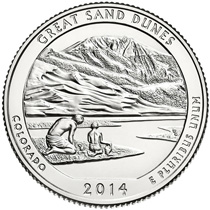
Great Sand Dunes National Park quarter design
In November of 2013, the U.S. Mint revealed the final design for the Great Sand Dunes National Park quarter. As the fourth release for 2014, this beautiful quarter will feature the sand dunes of this Colorado park, along with a mountain in the background, and father and son playing in the sand by the water in the foreground.
The waters of Medano Creek run from the melting snowpack at the base of the San de Cristo mountains through the sand to the south and east side of the dunes. In the summer if the creek has water, it is warm, and visitors love to splash and play in it. Eventually Medano Creek disappears back into the dunes’ aquifer that extends a mile below the surface. This is the lifeblood of the dunes. It keeps the sand moist, keeping it from spreading out and the dunes from vanishing.
The quarter’s reverse design was created by U.S. Mint sculptor-engraver Don Everhart. The reverse inscriptions read, name of the site: great sand dunes, colorado; year of issue: 2014; and the motto: e pluribus unum.
This handsome quarter is a perfect match for the 2006 Statehood Quarter, which also featured Colorado, the park’s home state. As 24th in the series overall, the Great Sand Dunes quarter will be the fourth coin for 2014.
April 30, 2014 – 11:29 am
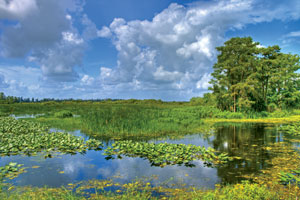
Everglades National Park
Everglades National Park spans 1.5 million acres across Florida’s tip, and includes Florida Bay. It is the largest park east of the Rockies and the third largest (after Yellowstone and Death Valley) in the lower 48 states. Established in 1947, this park is unusual because it was created to preserve natural habitat and ecosystems for a diverse group of plants, mammals, birds, and other creatures versus scenic vistas.
Now the 25th coin in the National Park quarter series and last for 2014 will honor this subtropical wilderness. This park is home to the endangered Florida panther, where currently 70-100 are thought to exist in the wild. Also on the endangered list are the manatee, wood stork, and American Crocodile.
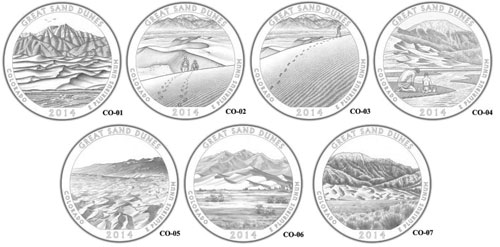
Great Sand Dunes National Park quarter candidate designs
In the fall of 2012, the Citizen’s Coinage Advisory Committee and the Commission of Fine
Arts reviewed five designs for the reverse of the 2014 Great Sand Dunes National Park quarter. All seven designs featured the dunes with mountains in the background. Three of the seven designs showed people enjoying the park’s natural beauty.
Humans have been part of this landscape for thousands of years, starting with hunter-gathers of the Stone Age who visited the area while hunting for mammoths and pre-historic bison. Later, Native Americans entered the region in search of food and supplies, and many believed it was a spiritual place.
Home to a wide variety of wildlife, Great Sand Dunes National Park offers access to miles of scenic landscape and mountainous terrain. Located north of the dunes is Mt. Herard, which at 13,353 feet, reveals a spectacular view of the dunes. Another peak further north, Tijeras Peak (scissors in Spanish) holds the title as the tallest in the park.





